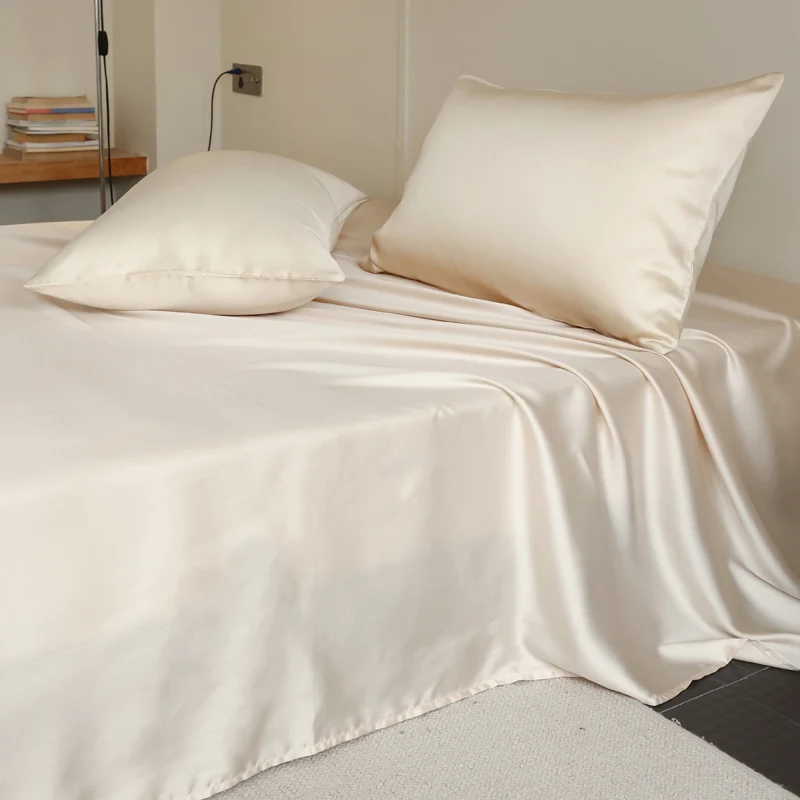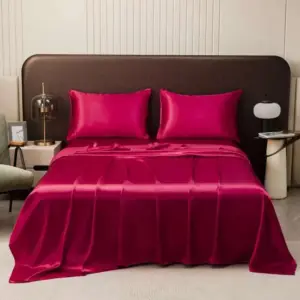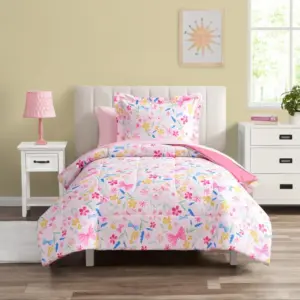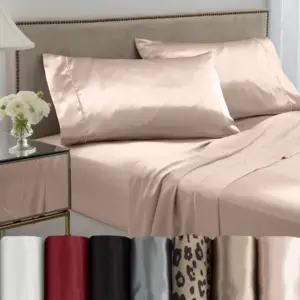Introduction
When shopping for silk sheets, many people make a common mistake: looking for high thread count numbers like they would with cotton sheets. If you’ve been searching for “1000 thread count silk sheets,” you might be surprised to learn that thread count isn’t actually the right measurement for silk quality at all.
Unlike cotton bedding, silk quality is primarily measured using “momme weight” (pronounced “moe-me”). This measurement indicates the weight in pounds of 100 yards of silk fabric that is 45 inches wide. Simply put, momme weight tells you how dense and substantial your silk sheets will be.
In this comprehensive guide, we’ll help you understand:
– Why thread count doesn’t apply to silk sheets
– How momme weight determines silk quality
– What momme weight range offers the best value and comfort
– Additional factors that indicate premium silk quality
– How to shop for silk sheets with confidence
At Sanctuary Soft, we specialize in premium silk bedding, and we’re sharing our expertise to help you make an informed choice for your sleep sanctuary.
Understanding the amazing benefits of Mulberry silk sheets begins with knowing what truly determines their quality. For those seeking comprehensive information, our complete guide to Mulberry silk bed sheets provides in-depth knowledge about this luxurious bedding option. Many shoppers wonder does thread count matter in silk bedding, and we’ll address this common misconception head-on.
Why Thread Count Doesn’t Apply to Silk Sheets
Thread count is a familiar metric for cotton sheets, referring to the number of threads woven into one square inch of fabric. Higher thread counts in cotton typically indicate softer, more durable sheets (to a point). However, this measurement system simply doesn’t work for silk.
The fundamental difference lies in the nature of the fibers themselves. Silk fibers are incredibly fine—up to 8 times thinner than cotton fibers. This natural fineness means that silk inherently has a very high thread density. Trying to count individual silk threads is impractical and doesn’t provide meaningful information about quality.
Additionally, silk is produced as a continuous filament fiber, unlike cotton’s staple fibers. A single silk filament from a silkworm cocoon can stretch unbroken for up to 1,000 yards. This creates a naturally smooth fabric regardless of thread count.
When manufacturers market silk sheets with thread count numbers, they’re usually applying a cotton-centric measurement to silk—which is misleading at best. The density of silk fabric is more appropriately measured by its weight rather than by counting threads.
The relationship between thread count and silk quality is fundamentally different than with cotton fabrics. Instead of focusing on thread count, explore quality Mulberry silk sheets that are properly measured by momme weight for true luxury.
Understanding Momme Weight: The True Measure of Silk Quality
Momme weight (often abbreviated as “mm”) is the industry standard for measuring silk quality. This Japanese measurement indicates the weight in pounds of a piece of silk fabric measuring 45 inches wide by 100 yards long.
Momme Definition: One momme equals 4.340 grams per square meter of fabric. The higher the momme number, the more silk is used per square inch.
When you touch silk sheets of different momme weights, you can physically feel the difference. Higher momme silk feels more substantial, drapes more luxuriously, and typically lasts longer. This isn’t just about heaviness—it’s about density. More silk per square inch means more of silk’s natural properties are present in the fabric.
Think of momme as similar to thread count in one important way: it indicates how much material is packed into the fabric. However, instead of counting individual threads (which would be impractical with silk’s fine fibers), momme measures the actual weight of the silk itself.
This weight measurement directly translates to practical qualities you’ll experience:
– Durability (higher momme generally lasts longer)
– Drape (how elegantly the fabric falls)
– Opacity (how translucent or opaque the fabric appears)
– Feel (the substantialness against your skin)
Choosing the right momme silk sheets is essential for getting the experience you desire. For those still confused about different measurement systems, our guide on momme vs thread count silk guide explains the key differences.
Ideal Momme Weight Range for Silk Sheets
For silk sheets that balance luxury, durability, and value, the ideal momme weight range is typically between 19 and 25 momme. This range offers the sweet spot where silk is substantial enough to be durable while maintaining its characteristic softness and drape.
Silk sheets below 19 momme tend to be too lightweight for bedding—they may feel too delicate and won’t last as long. On the other hand, silk above 28 momme becomes extremely expensive and may actually feel too heavy for comfortable year-round use.
Here’s a quick reference guide to help you choose:
| Momme Range | Quality Level | Best For |
|---|---|---|
| 16-19mm | Economy | Budget-conscious buyers, guest rooms |
| 19-22mm | Standard Quality | Everyday use, excellent value |
| 22-25mm | Luxury | Main bedrooms, premium experience |
| 25-30mm | Ultra Premium | Maximum luxury, special occasions |
Most high-quality silk sheets fall within the 19-25 momme range, with 22 momme being particularly popular for offering an excellent balance of quality and value.

Our collection of luxury silk bedding sets features products in the ideal momme weight range for superior comfort and longevity.
Detailed Breakdown of Momme Weight Options
19 Momme Silk Sheets
At 19 momme, silk sheets feel lightweight yet substantial enough for bedding. This weight offers excellent breathability and a slightly more delicate drape.
Pros:
– Most affordable quality option
– Extremely soft and lightweight
– Superior breathability for hot sleepers
– Natural cooling properties
Cons:
– Less durable than heavier weights
– Slightly more translucent
– May require more delicate handling
Best for: Hot sleepers, summer use, those on a budget who still want genuine silk quality, and guest rooms.
Price expectation: Entry-level premium pricing
22 Momme Silk Sheets
At 22 momme, you’ll find the optimal balance for most users. This weight provides substantialness without excessive heaviness, and durability without sacrificing silk’s natural drape.
Pros:
– Excellent balance of durability and softness
– Good opacity while maintaining breathability
– Better longevity than lighter weights
– Still reasonably priced compared to heavier weights
Cons:
– Higher price point than 19 momme
– May feel slightly less airy than lighter weights
Best for: Everyday use, primary bedrooms, year-round comfort, and long-term value.
Price expectation: Mid-range premium pricing
25 Momme Silk Sheets
At 25 momme, silk sheets provide a truly luxurious experience with excellent durability and substantial feel.
Pros:
– Superior durability and longevity
– More substantial feel against the skin
– Excellent drape and visual appeal
– Greater opacity
Cons:
– Higher price point
– May feel slightly heavier in very hot weather
Best for: Luxury master bedrooms, those seeking maximum durability, and cooler climates.
Price expectation: High premium pricing
28+ Momme Silk Sheets
At 28 momme and above, silk reaches its most substantial form for bedding applications.
Pros:
– Maximum durability and longevity
– Luxuriously substantial feel
– Highest opacity
– Impressive visual weight and drape
Cons:
– Highest price point
– May feel too heavy for some sleepers or seasons
– Limited availability
Best for: Ultimate luxury, special occasions, investment pieces, and cooler climates.
Price expectation: Ultra-premium pricing
Explore our collection of 100% silk sheets in various momme weights to find your perfect match.
Types of Silk: Why 100% Mulberry Silk is Superior
While momme weight tells you about silk’s density, the type of silk indicates its fundamental quality and characteristics. Among all silk varieties, 100% pure Mulberry silk stands as the industry gold standard for luxury bedding.
Mulberry silk comes from silkworms (Bombyx mori) that are fed exclusively on mulberry leaves under carefully controlled conditions. This specialized diet produces exceptionally fine, strong, and uniform silk filaments with these distinctive characteristics:
- Long-strand fibers: Creates smoother, more durable fabric with fewer weak points
- Uniform texture: Provides consistent feel and appearance throughout
- Natural white color: Takes dyes beautifully for rich, consistent coloration
- Exceptional smoothness: Creates the characteristic silky feel against skin
Other silk types you might encounter include:
- Tussah silk: From wild silkworms, coarser with shorter fibers and brownish color
- Charmeuse: A weaving technique rather than a silk type (often using Mulberry silk)
- Habotai: A lightweight, plain-weave silk usually used for linings or summer garments
For bedding specifically, Mulberry silk’s combination of smoothness, durability, and consistent quality makes it vastly superior to other options. Its natural protein structure also provides the hypoallergenic and skin-friendly benefits that make silk bedding so desirable.
What makes Mulberry silk special goes beyond just its softness—it’s a unique natural material with properties that synthetic alternatives simply cannot replicate. Browse our collection of silk sheets to experience the difference for yourself.
Understanding Silk Grading Systems
Beyond momme weight and silk type, another important quality indicator is the silk grading system. Most commonly expressed as “A” grades, this classification helps further differentiate quality levels within Mulberry silk.
| Grade | Quality Level | Characteristics |
|---|---|---|
| 6A | Premium | Longest, most uniform fibers; minimal imperfections; highest luster |
| 5A | High Quality | Very long fibers; minimal variations; excellent luster |
| 4A | Good Quality | Good fiber length; some minor variations; good luster |
| 3A and below | Standard/Basic | Shorter fibers; more variations; moderate luster |
Grade 6A represents the pinnacle of silk quality, featuring the longest and most uniform silk fibers with minimal imperfections. The grading considers several factors:
- Fiber length and uniformity
- Color consistency
- Impurity content
- Tensile strength
- Surface evenness
Higher grades translate directly to better feel, appearance, durability, and overall luxury. When combined with appropriate momme weight, Grade 6A silk creates bedding that’s not only exceptionally comfortable but also maintains its beauty and performance over many years.
When shopping, look for explicit grade labeling from reputable manufacturers. Premium brands are typically transparent about their silk grade, with luxury options almost exclusively using Grade 6A.
The Importance of Silk Weave Patterns
The weave pattern of silk fabric significantly impacts its appearance, feel, and functionality as bedding. For silk sheets, the most common and desirable weave is Charmeuse (sometimes called Satin weave when referring to the technique rather than the material).
Charmeuse silk features:
– A smooth, glossy surface on one side
– A more matte, textured surface on the reverse
– Excellent drape and flow
– The characteristic “slippery” feel associated with luxury silk
This weave structure creates the perfect balance of smoothness against the skin while allowing the fabric to remain breathable. The slight sheen catches light beautifully, enhancing the luxury appearance of the bedding.
Other silk weaves you might encounter include:
- Crepe de Chine: A slightly textured, less shiny weave with a matte appearance
- Habotai: A plain, lightweight weave that’s less common for quality bedding
- Georgette: A lightweight, slightly crinkled texture, rarely used for sheets
For bedding applications, Charmeuse remains the preferred choice as it maximizes silk’s natural benefits while providing the durability needed for regular use.
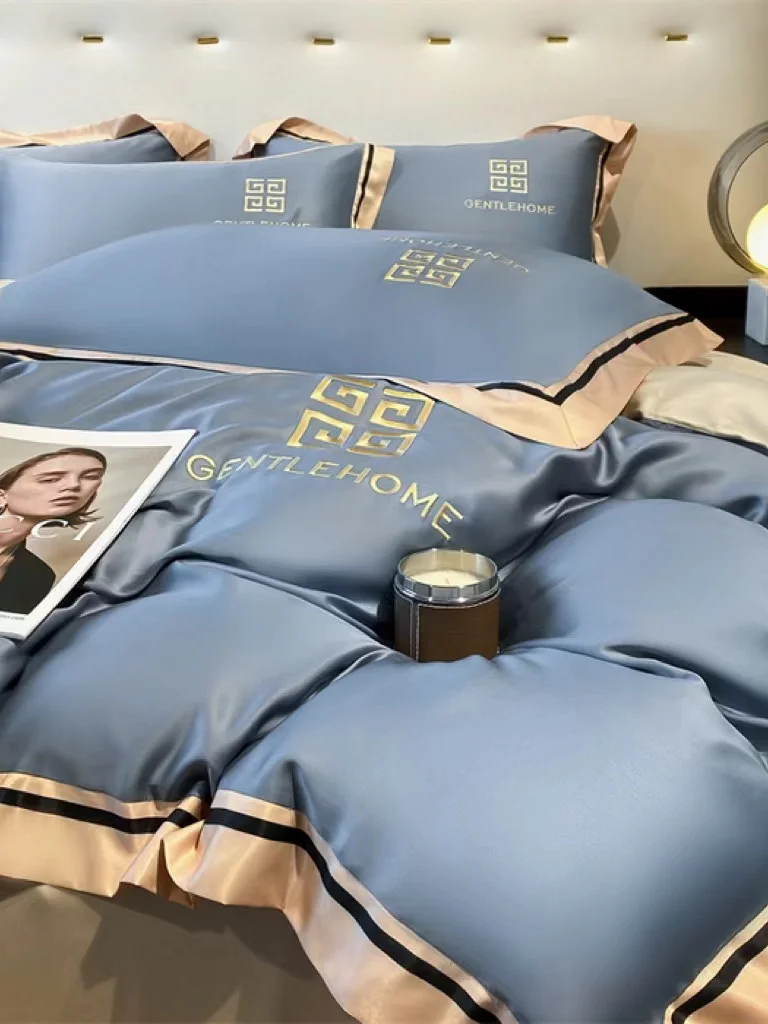
Certifications and Ethical Considerations
Quality silk sheets often come with certifications that indicate their safety and production standards. These certifications provide assurance beyond just the physical properties of the silk.
The most important certification to look for is OEKO-TEX Standard 100, which tests for:
– Harmful substances
– Regulated chemicals
– Known irritants
– pH balance suitable for skin contact
This certification ensures that every component of your silk sheets—from the fabric to the dyes to the thread used in stitching—is safe for prolonged skin contact, making it particularly important for bedding you’ll spend 8+ hours against each night.
Other meaningful certifications may include:
– Organic certifications (for the mulberry leaves used to feed silkworms)
– Fair trade certifications (ensuring ethical labor practices)
– Environmental stewardship certifications
These standards not only indicate a quality-focused manufacturer but also reflect ethical considerations that many consumers value. Premium brands invest in these certifications as part of their commitment to overall excellence.
Craftsmanship Details That Indicate Quality
Beyond the silk itself, the construction details of silk sheets reveal much about their overall quality. Expert craftsmanship ensures that the finished product maximizes the natural benefits of silk while providing durability and visual appeal.
Key quality indicators include:
- Stitching quality: Look for tight, even seams with no loose threads or puckering
- French seams: These enclosed seams prevent fraying and provide a cleaner, more durable finish
- Pillowcase construction: High-quality envelope closures or hidden zippers that keep pillows secure
- Fitted sheet depth: Generous pocket depth with elastic that fully encircles the sheet
- Color consistency: Even dyeing throughout with no blotches or fading
- Edge finishing: Neat hems with proper allowance and secure stitching
These details may seem minor, but they significantly impact both the lifespan and the day-to-day experience of using silk sheets. Quality manufacturers pay attention to these construction elements, creating bedding that maintains its integrity through years of use and washing.
The Health and Comfort Benefits of Premium Silk Sheets
Quality silk sheets offer unique benefits that justify their premium price point. Understanding these advantages helps explain why silk has been treasured as a luxury bedding material for centuries.
Temperature Regulation
Silk naturally adjusts to your body temperature, helping maintain comfort within 1-2°F of optimal sleeping temperature. It wicks moisture away while providing insulation when needed, making it suitable for year-round use.
Hypoallergenic Properties
Natural silk protein (sericin) resists common allergens including:
– Dust mites
– Mold and mildew
– Many common bacteria
– Fungal spores
This makes silk an excellent choice for allergy sufferers and those with sensitive skin.
Beauty Benefits
Silk’s smooth surface creates less friction against skin and hair than cotton, which can help:
– Reduce facial creasing and sleep wrinkles
– Minimize hair breakage and bedhead
– Preserve hairstyles and extensions longer
Moisture Balance
Silk allows skin to maintain natural moisture levels without absorbing facial products, unlike cotton which can wick away beneficial moisture and skincare products during sleep.
Higher momme weights and superior silk grades enhance these natural benefits, providing better temperature regulation, increased durability, and improved moisture management. The hypoallergenic features of silk sheets make them particularly valuable for sensitive individuals, while Mulberry silk bedding offers significant skin benefits beyond just comfort.
How to Shop Smart for Silk Sheets
Armed with knowledge about momme weight, silk types, and quality indicators, you can shop confidently for silk sheets. Follow these guidelines to ensure you’re getting authentic, high-quality silk bedding:
Verify the label specifications: Look for explicit details including:
– “100% Pure Mulberry Silk” (not just “silk” or “satin”)
– Specific momme weight (ideally 19-25mm)
– Silk grade (preferably 6A)Be wary of misleading terminology: Watch out for phrases like:
– “Silk-like” or “silky” (indicates synthetic materials)
– “Satin” without specifying silk (likely polyester)
– “Silk blend” (contains other fibers)
– “Silk-rich” (may contain minimal actual silk)Check for quality certification: Look for OEKO-TEX or other reputable certifications that ensure safety standards.
Assess the feel: Quality silk should:
– Feel smooth but not slippery or sticky
– Have a subtle, natural luster (not high shine like polyester)
– Feel cool to the initial touch
– Have sufficient weight for its momme ratingUnderstand price expectations: Quality silk sheets typically range from:
– $300-450 for 19mm queen sets
– $400-600 for 22mm queen sets
– $500-800+ for 25mm queen sets
– Significantly lower prices often indicate inauthentic or low-quality productsResearch the brand: Look for:
– Detailed product descriptions with specific silk metrics
– Transparent manufacturing information
– Genuine customer reviews
– Clear care instructions
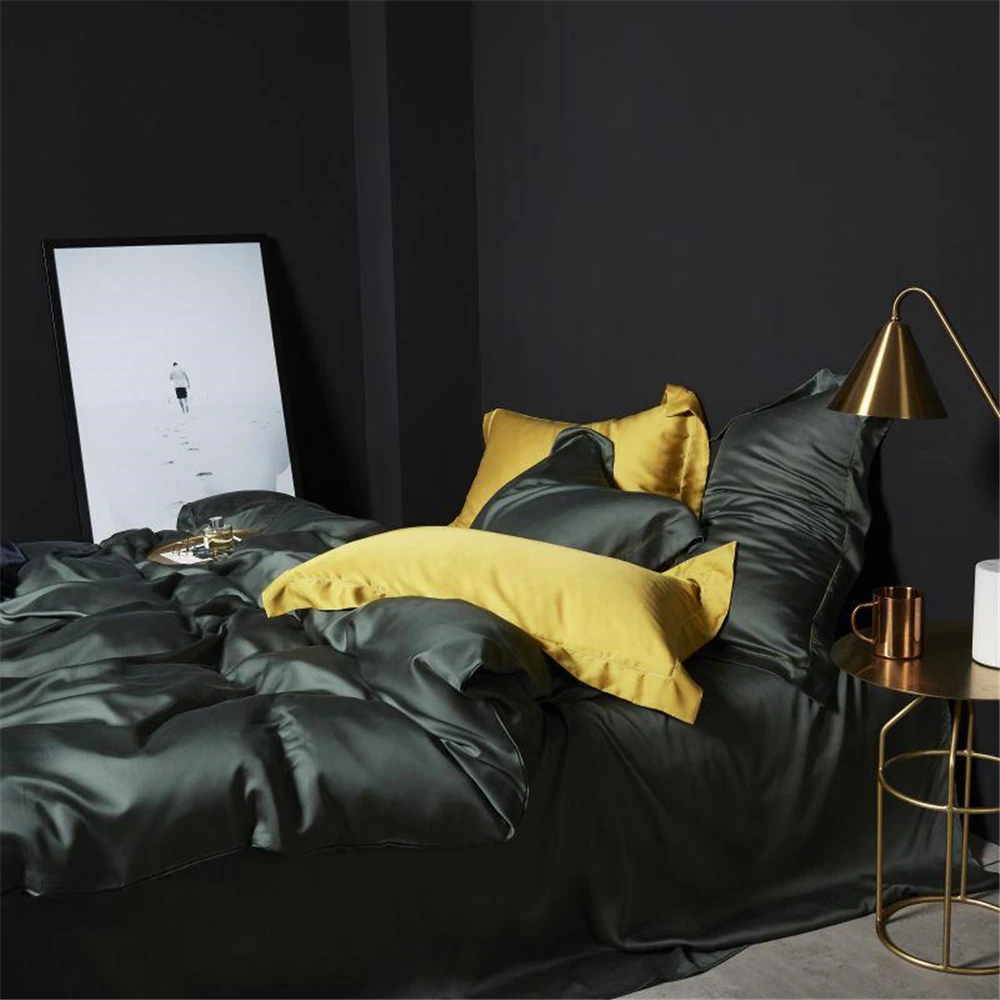
The ultimate guide to buying luxury silk bedding provides even more detailed shopping advice for finding premium silk bedding that meets your needs.
Full-size Silk Sheets, King Size Silk Sheets, Queen Size Silk Sheets, Twin Size Silk Sheets, Washable Silk Sheets
Price range: $95.95 through $178.37 Select options This product has multiple variants. The options may be chosen on the product page100% Silk Sheets, Green Silk Sheets, King Size Silk Bedding Set, Mulberry Silk Bedding Sets, Queen Size Silk Bedding Set
Price range: $1,246.21 through $1,615.22 Select options This product has multiple variants. The options may be chosen on the product pagePink Silk Sheets, Twin Size Silk Sheets
$171.80 Select options This product has multiple variants. The options may be chosen on the product pageFull-size Silk Sheets, Pink Silk Sheets
$136.31 Select options This product has multiple variants. The options may be chosen on the product pageGrey Silk Sheets, Silk Sheet and Pillowcase Set
Price range: $88.20 through $146.64 Select options This product has multiple variants. The options may be chosen on the product pageBamboo Silk Sheets, Cooling Silk Sheets
Price range: $130.76 through $177.80 Select options This product has multiple variants. The options may be chosen on the product page
Simple Care Guidelines for Extending Silk Sheet Life
Proper care dramatically extends the lifespan of your silk sheets, making them an even better investment. These simple guidelines help maintain silk’s beauty and performance:
Do:
– Hand wash or use washing machine’s gentle/delicate cycle
– Use cold water (under 86°F/30°C)
– Select mild, silk-specific detergent without enzymes or brighteners
– Air dry away from direct sunlight
– Iron on low heat with a pressing cloth if needed
– Store clean, dry silk in breathable fabric bags
Don’t:
– Use bleach, fabric softeners, or stain removers
– Wash with rough items like denim
– Twist or wring silk when wet
– Tumble dry on high heat
– Expose to direct sunlight for extended periods
– Store in plastic containers
With proper care, quality silk sheets can last for many years—often outlasting cotton sheets despite their delicate appearance. The initial investment pays dividends through longevity and continued performance.
Common Misconceptions About Silk Sheets
Many people have misconceptions about silk bedding that might prevent them from experiencing its benefits. Let’s address some common myths:
Myth: Silk sheets are too slippery to sleep on comfortably.
Reality: Quality silk has natural temperature regulation that creates just enough grip—it’s smooth but not slippery like synthetic satin. The right momme weight (22mm+) provides sufficient substance to prevent excessive sliding.
Myth: Silk is too delicate for regular use as bedding.
Reality: While silk requires gentle care, properly made silk sheets (19-25mm) are surprisingly durable and can last for many years with appropriate handling. They’re suitable for nightly use, not just special occasions.
Myth: Silk is too warm for summer use.
Reality: Silk is actually one of the most temperature-adaptive natural fibers, wicking moisture and allowing airflow to maintain comfortable sleeping temperatures year-round. It feels cool in summer and warm in winter.
Myth: Silk requires dry cleaning.
Reality: Most quality silk sheets are washable at home using gentle cycles and appropriate detergents. Always check care instructions, but dry cleaning is rarely required for modern silk bedding.
Conclusion
When shopping for silk sheets, remember that thread count is not the metric that matters. Instead, focus on momme weight as the primary indicator of silk quality, with 19-25mm offering the best balance of luxury, durability, and value for most users.
For the ideal combination of factors, look for:
– 22mm weight (balancing substance and drape)
– 100% pure Mulberry silk (not blends or synthetic alternatives)
– Grade 6A classification (ensuring premium fiber quality)
– Proper construction details that enhance durability
Understanding these quality indicators empowers you to make informed decisions when investing in silk bedding. Quality silk sheets represent more than just luxury—they provide tangible benefits for sleep comfort, skin health, and overall well-being.
By focusing on these meaningful metrics rather than misleading thread count numbers, you’ll be able to select silk sheets that deliver the exceptional experience this premium material should provide.

